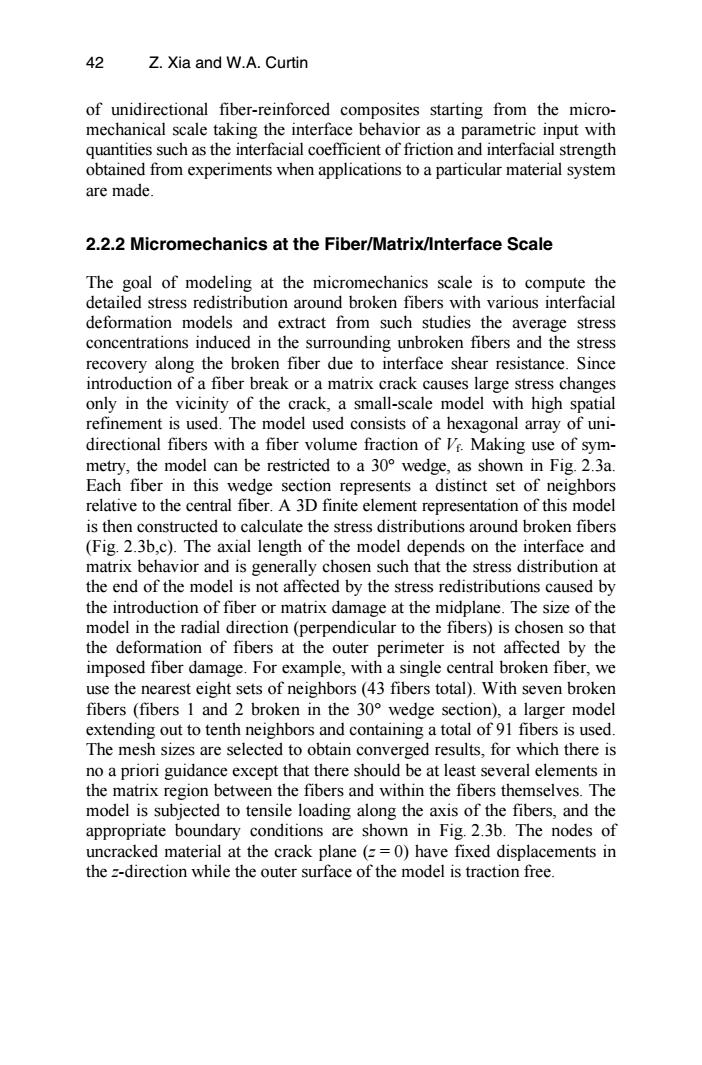正在加载图片...

42 Z.Xia and W.A.Curtin of unidirectional fiber-reinforced composites starting from the micro- mechanical scale taking the interface behavior as a parametric input with quantities such as the interfacial coefficient of friction and interfacial strength obtained from experiments when applications to a particular material system are made. 2.2.2 Micromechanics at the Fiber/Matrix/Interface Scale The goal of modeling at the micromechanics scale is to compute the detailed stress redistribution around broken fibers with various interfacial deformation models and extract from such studies the average stress concentrations induced in the surrounding unbroken fibers and the stress recovery along the broken fiber due to interface shear resistance.Since introduction of a fiber break or a matrix crack causes large stress changes only in the vicinity of the crack,a small-scale model with high spatial refinement is used.The model used consists of a hexagonal array of uni- directional fibers with a fiber volume fraction of Vr.Making use of sym- metry,the model can be restricted to a 30 wedge,as shown in Fig.2.3a. Each fiber in this wedge section represents a distinct set of neighbors relative to the central fiber.A 3D finite element representation of this model is then constructed to calculate the stress distributions around broken fibers (Fig.2.3b,c).The axial length of the model depends on the interface and matrix behavior and is generally chosen such that the stress distribution at the end of the model is not affected by the stress redistributions caused by the introduction of fiber or matrix damage at the midplane.The size of the model in the radial direction(perpendicular to the fibers)is chosen so that the deformation of fibers at the outer perimeter is not affected by the imposed fiber damage.For example,with a single central broken fiber,we use the nearest eight sets of neighbors(43 fibers total).With seven broken fibers (fibers 1 and 2 broken in the 30 wedge section),a larger model extending out to tenth neighbors and containing a total of 91 fibers is used The mesh sizes are selected to obtain converged results,for which there is no a priori guidance except that there should be at least several elements in the matrix region between the fibers and within the fibers themselves.The model is subjected to tensile loading along the axis of the fibers,and the appropriate boundary conditions are shown in Fig.2.3b.The nodes of uncracked material at the crack plane (=0)have fixed displacements in the z-direction while the outer surface of the model is traction freeof unidirectional fiber-reinforced composites starting from the micromechanical scale taking the interface behavior as a parametric input with quantities such as the interfacial coefficient of friction and interfacial strength obtained from experiments when applications to a particular material system are made. 2.2.2 Micromechanics at the Fiber/Matrix/Interface Scale The goal of modeling at the micromechanics scale is to compute the detailed stress redistribution around broken fibers with various interfacial deformation models and extract from such studies the average stress concentrations induced in the surrounding unbroken fibers and the stress recovery along the broken fiber due to interface shear resistance. Since introduction of a fiber break or a matrix crack causes large stress changes only in the vicinity of the crack, a small-scale model with high spatial refinement is used. The model used consists of a hexagonal array of unidirectional fibers with a fiber volume fraction of Vf. Making use of symmetry, the model can be restricted to a 30° wedge, as shown in Fig. 2.3a. Each fiber in this wedge section represents a distinct set of neighbors relative to the central fiber. A 3D finite element representation of this model is then constructed to calculate the stress distributions around broken fibers (Fig. 2.3b,c). The axial length of the model depends on the interface and matrix behavior and is generally chosen such that the stress distribution at the end of the model is not affected by the stress redistributions caused by the introduction of fiber or matrix damage at the midplane. The size of the model in the radial direction (perpendicular to the fibers) is chosen so that the deformation of fibers at the outer perimeter is not affected by the imposed fiber damage. For example, with a single central broken fiber, we use the nearest eight sets of neighbors (43 fibers total). With seven broken fibers (fibers 1 and 2 broken in the 30° wedge section), a larger model extending out to tenth neighbors and containing a total of 91 fibers is used. The mesh sizes are selected to obtain converged results, for which there is no a priori guidance except that there should be at least several elements in the matrix region between the fibers and within the fibers themselves. The model is subjected to tensile loading along the axis of the fibers, and the appropriate boundary conditions are shown in Fig. 2.3b. The nodes of uncracked material at the crack plane (z = 0) have fixed displacements in the z-direction while the outer surface of the model is traction free. 42 Z. Xia and W.A. Curtin